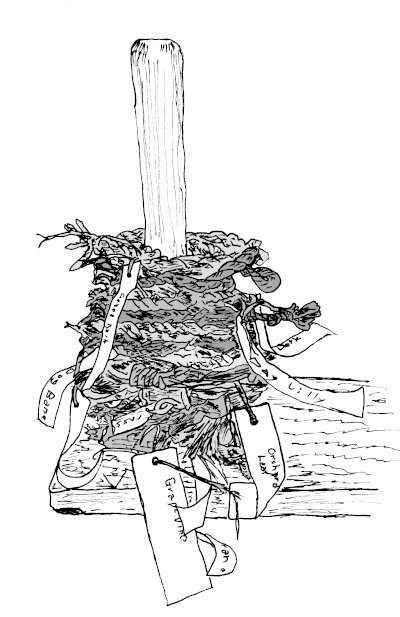Ink
One question I've been asked is if I make my own ink.

Figure 1: Reed Pen and a Bottle of Ink.
This always
strikes me as an odd question to ask a ropemaker. Rope and writing
not having many overlaps. But the answer is mostly "yes".

Figure 2: Labels on Rope Samples.
I have labels on sample ropes, reminding me which
fibers are which. Sometimes I cheat
and use a modern pen, but I keep a jar of "real" ink around
for when I want to be totally correct.
Recipe
I make an iron - gall ink, something that has been around for
centuries.
This ink is fairly faint when it is wet, but dries anywhere from
a nice brown to almost bluish black.
The ingredients are simple:
Acid
Traditional acids are vinegar or wine. I use vinegar because it's
cheaper and save the wine for other uses. It doesn't matter what kind
of vinegar. You don't have to worry about cider vinegar leaving a
stain, because that's the whole idea. Whatever is in the pantry
or cheapest at the market. You don't want a real strong acid, or
your ink will eat holes through your document.
Iron
Some sources say you just drop a nail or small scrap
of iron in the jar with the vinegar.
I dunk a wad of steel wool into the jar on the hope the
greater surface area will work faster.
Tannins
Historically the tannins were from oak galls. The galls, or oak
apples, are caused by a wasp larva. Not something most people
are going to have ready access to.
You can use really, really
strong tea. However, tea was not a popular ingedient in the
Colonial era, as the Boston Tea Party and the burning
of the Peggy Stewart point out.
Black Walnut (Juglans nigra) husks are also
a good source of tannins. But there are many other tannin sources.
Explore.
Preparation
You can find many different methods of preparing this ink.
This is what works for me, and has for several years.
But I am just using this ink for an occasional label.
If you are doing fine calligraphy, you might want a more
formal, repeatable, process.
(NOTE: the
Wikipedia[6]
article has several governments' recipes for
iron gall inks that are used for official records.)
I use a quart Mason jar for mixing and storage. You really shouldn't
need more than this. Even a cup, (8 fluid ounces) of ink will
cover many pages of writing. Commercial inks are generally sold in
one or two fluid ounce bottles.
- Fill the jar about half full of vinegar.
- Put the steel wool in the vinegar. Bubbles
may form, so check it occaisionally, and
push the steel wool down, as needed.
- If you are using a solid piece of iron, just
drop it in the vinegar.
- Make a real strong mug of tea. Something like three
teabags in a mug of water. Let it steep a good long
while. Squeeze all the liquid out of the teabags
into the mug, and dump the tea into the vinegar.
- If you are using Black Walnut husks, toss them into
the vinegar along with everything else.
If you are using another source of tannins,
you are on your own. Experimenting is learning.
- Let the jar sit, uncovered, for several days. Swish
the contents around every now and then. The longer
it sits, the stronger the color.
- Cut yourself a reed or quill pen and see how it writes.
NOTE: The acid in iron - gall ink will eventually corrode a
metal pen nib. But for the Colonial era, you shouldn't
be using a metal nib anyway.
You can top up your ink supply by adding more iron, another
teabag or walnut, and some water or vinegar if your ink has evaporated.
Swish the ink before you dip your pen, and don't dip too deeply.
I've been using the same jar full of ink for over a year.
The color changes over time as the ratio of materials change, but
that is fine. Uniformity was rare, back in the day.
Notes:
- Too much iron can be bad for you. Do not drink your iron -
gall ink. Keep it away from young ones and pets.
- Please test in an inconspicuous place, or on a scrap, before committing
to an important project. This is a penetrating and permanent ink.
- The acids in iron - gall inks can eat through paper after
a long while. This is a problem faced by curators of
important document collections. This is not a problem
for me, because the things I write don't need to last
a hundred years.
Other Uses
After a clumsy accident in the shop one day, I found
iron - gall ink makes an interesting, and historically
correct, wood stain. In traditional woodworking,
they call it "ebonizing".[2]
[5]
It aslo worked as a blue-black dye on tanned leather.
Turns out leather workers call this a
"vinegaroon".[1]
[3]
Bibliography
I actually found these sources a long time after
I'd written this page. But they give different perspectives
on the traditions and recipies.
Some of these pages get into the actual chemistry involved.
Chemistry isn't one of my strong subjects, but these
are a place to start, if you are interested.
1
Adams, Eric (September 2012)
Vinegaroon – A.K.A. Vinegar Black
Accessed 22 June 2025
https://www.adamsleatherworks.com/post/vinegaroon-a-k-a-vinegar-black
2
Boggs, Brian (February 2021)
How To Ebonize Wood
Accessed 22 June 2025
https://www.popularwoodworking.com/finishing/ebonizing_wood/
3
kop4 (January 2017)
My guide to the best vinegaroon you've ever made.
Accessed 22 June 2025
https://leatherworker.net/forum/topic/73637-my-guide-to-the-best-vinegaroon-youve-ever-made/
4
McFarling, Usha (May 2019)
Making Ink from Oak Galls
Accessed 22 June 2025
https://www.huntington.org/verso/making-ink-oak-galls
5
Vondriska, George (September 2018)
Ebonizing Wood
Accessed 22 June 2025
https://www.wwgoa.com/post/ebonizing-wood/
6
Wikipedia
Iron gall ink
Accessed 22 June 2025
https://en.m.wikipedia.org/wiki/Iron_gall_ink


